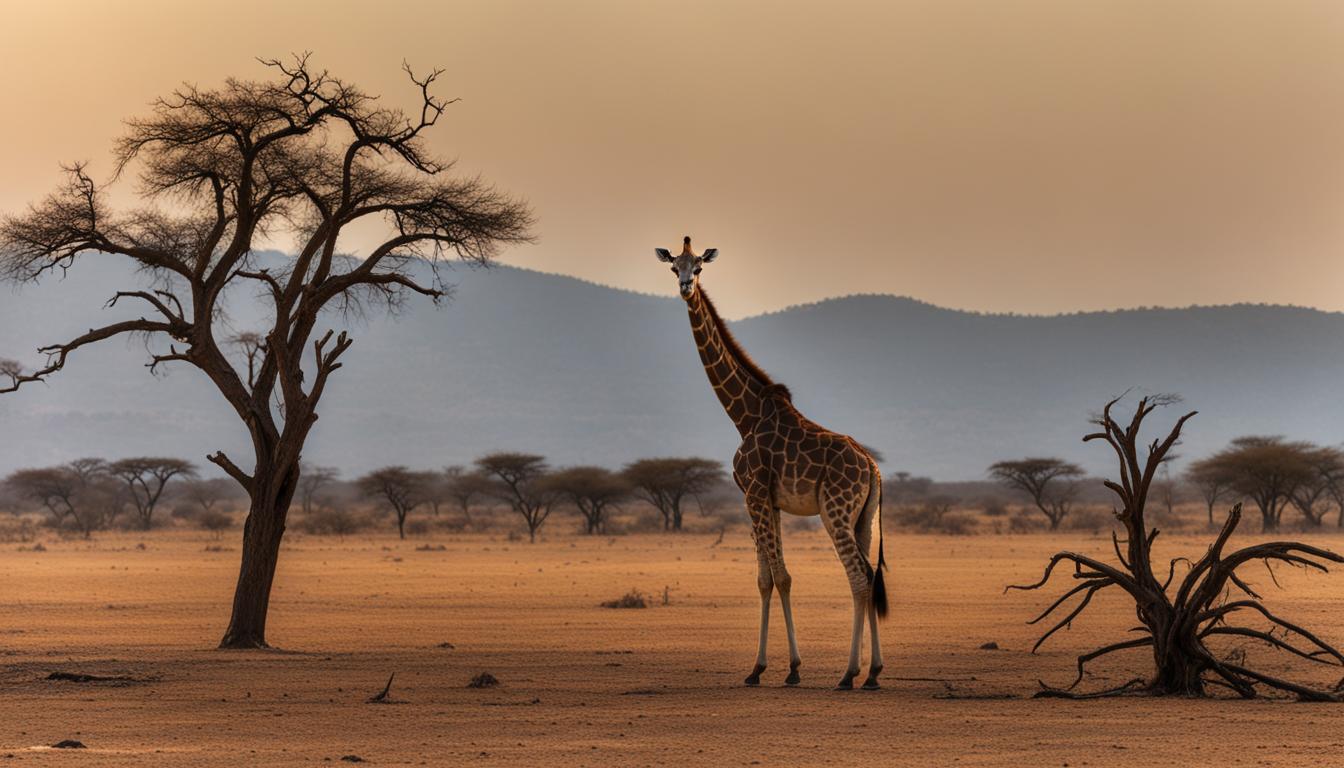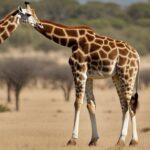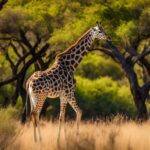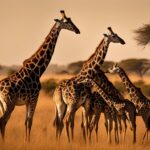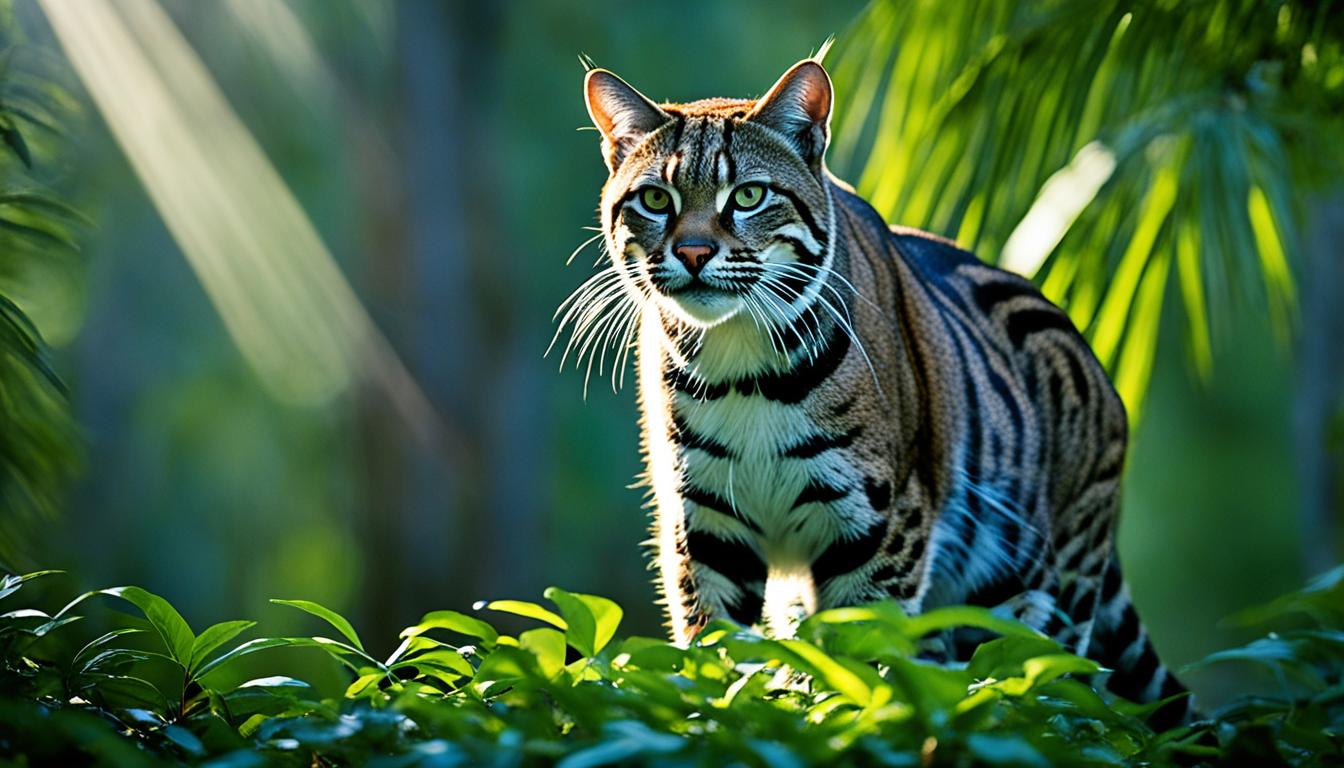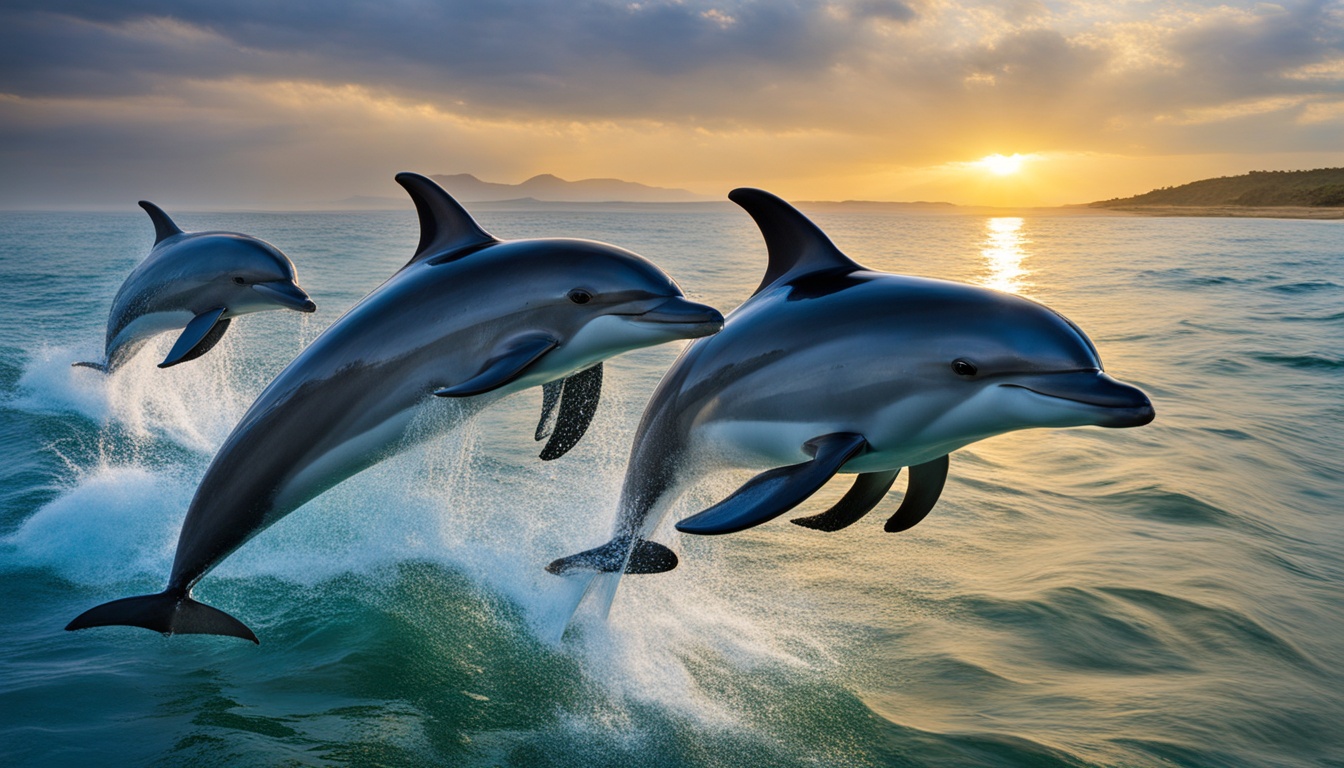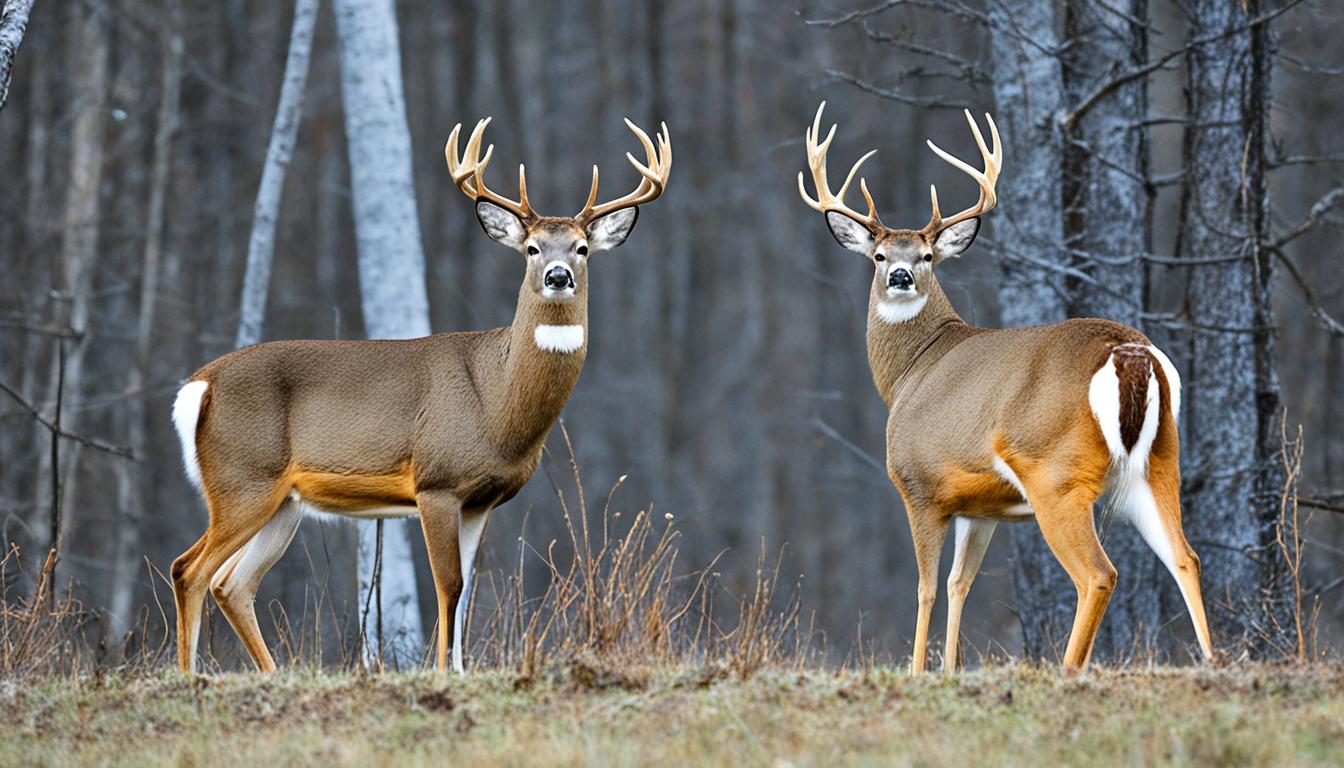Giraffes, one of the most iconic and majestic creatures of the animal kingdom, are facing a grave threat due to the effects of climate change on their habitats. The changing climate, characterized by increasing temperatures and erratic rainfall patterns, has led to significant consequences for these elegant creatures, including habitat loss and a decline in their population.
The effects of climate change on giraffes are far-reaching. With the altered weather patterns, the availability of food sources for giraffes has been severely impacted. The habitat of giraffes is shrinking as deforestation and agricultural activities remove the essential trees that these beautiful creatures rely upon for nourishment.
Moreover, the challenges posed by climate change compound other threats that giraffes face, such as vehicle collisions, illegal poaching, civil unrest, and emerging diseases. These factors collectively contribute to the alarming decline in the giraffe population, which has witnessed a staggering 40 percent decrease in the past 30 years.
In the face of this crisis, giraffe conservation becomes vital. Protecting their habitats and addressing the impact of climate change are crucial steps to safeguard these remarkable creatures for future generations. By understanding the effects of climate change on giraffes and actively supporting conservation efforts, together, we can ensure the survival and well-being of these majestic beings.
The Silent Extinction of Giraffes
Scientists have referred to the decrease in the giraffe population as the “Silent Extinction.” Over the past three decades, the population of giraffes has declined by 40 percent, leaving less than 100,000 giraffes remaining today. The decline is mainly attributed to habitat loss, including deforestation and agriculture, which remove essential trees that giraffes rely on for food. The loss of suitable habitats for giraffes has also led to an increase in threats such as vehicle collisions and illegal poaching.
“The Silent Extinction refers to the alarming decline in the giraffe population, which is a significant concern for conservationists and researchers alike. If immediate action is not taken, we risk losing these majestic creatures forever.” – Jane Wilson, Giraffe Conservationist
Efforts are being made to conserve the giraffe population, particularly the subspecies that have been added to the Critically Endangered list by the International Union for Conservation of Nature (IUCN) Red List of Threatened Species. These conservation efforts focus on protecting and restoring giraffe habitats, implementing stronger regulations against poaching and illegal trade, and raising awareness about the importance of giraffes in the ecosystem.
Giraffe Population by Subspecies:
| Subspecies | Population | Status |
|---|---|---|
| Reticulated Giraffe | 15,780 | Near Threatened |
| Masai Giraffe | 35,000 | Vulnerable |
| Nubian Giraffe | 450 | Critically Endangered |
| Rothschild’s Giraffe | 1,600 | Endangered |
| Somali Giraffe | 7,500 | Vulnerable |
| South African Giraffe | 45,000 | Least Concern |
Conservation efforts and public support are crucial to reversing the decline of giraffes and ensuring their long-term survival. By working together, we can protect these magnificent animals and preserve their place in the natural world for generations to come.
Impact of Climate Change on Giraffes
Climate change is having a profound impact on giraffes and their natural habitats. The changing weather patterns, including increased temperatures and altered rainfall, are disrupting the availability of suitable food sources for giraffes. As a result, these magnificent creatures are facing food shortages and are being forced to adapt their behavior to survive in these changing conditions.
Giraffes, known for their ability to browse on tall trees, are particularly vulnerable to habitat changes caused by climate change. The loss of essential trees due to deforestation and agricultural activities further exacerbates the food shortage for giraffes. These trees take years to grow back to the suitable height for giraffes to reach, leading to a significant decrease in browsing options and an overall decline in the giraffe population.
“The impact of climate change on giraffes is a significant concern for their long-term survival. Their ability to adapt to rapidly changing conditions is being tested, and without targeted conservation efforts, we risk losing these iconic animals forever.”
Conservation efforts focused on addressing climate change and protecting giraffe habitats are crucial to the survival of these majestic creatures. By reducing our carbon footprint and advocating for sustainable practices, we can help mitigate the effects of climate change that threaten giraffe populations. Supporting organizations that work towards giraffe conservation and raising awareness about the importance of protecting their habitats are also essential in ensuring a future for these incredible animals.
In summary, climate change poses significant challenges for giraffes, affecting their behavior, food availability, and overall survival. Taking action to combat climate change and supporting giraffe conservation efforts are necessary steps in safeguarding these magnificent creatures for generations to come.
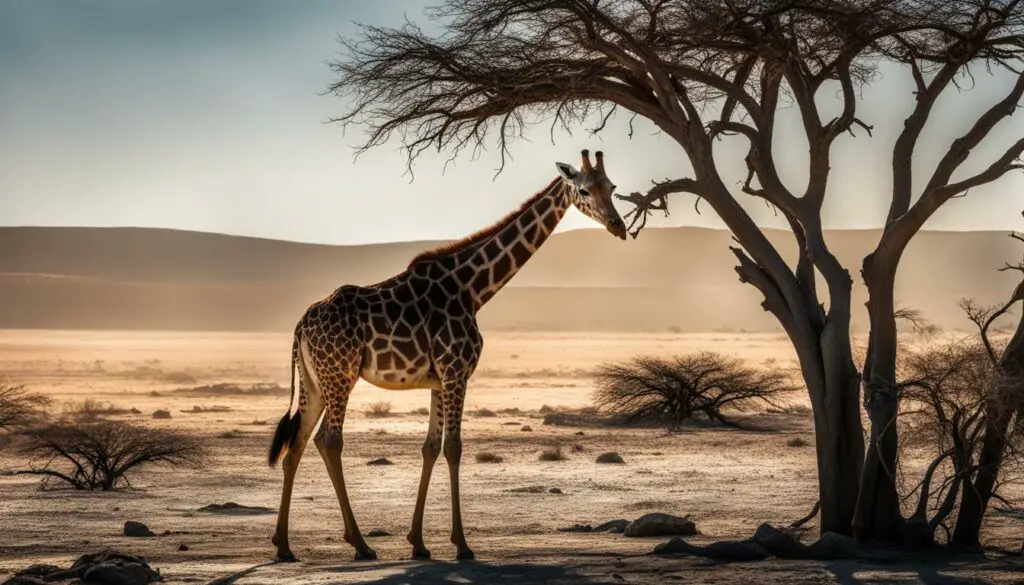
Giraffes and Habitat Loss
Giraffes, magnificent creatures known for their long necks and graceful appearance, are currently facing a critical threat – habitat loss. The effects of deforestation and agriculture have greatly impacted the habitats that giraffes rely on for sustenance and survival. The removal of tall trees, which are crucial food sources for giraffes, has resulted in a limited availability of browsing options for these gentle giants.
Deforestation, driven by human activities such as logging and land conversion, has left giraffes with fewer suitable habitats to thrive in. As a result, their population has suffered, and they are now listed as vulnerable on the International Union for Conservation of Nature (IUCN) Red List of Threatened Species.
The impact of agriculture on giraffe habitats cannot be overlooked either. The expansion of farms and ranches has encroached upon the natural territories of giraffes, further exacerbating their habitat loss. Additionally, the charcoal industry, which relies on extensive tree cutting, has further contributed to the destruction of giraffe habitats.
Giraffes at Risk: A Table on Habitat Loss
| Year | Reason for Habitat Loss | Impact on Giraffes |
|---|---|---|
| 2010 | Deforestation | Loss of food sources and suitable browsing options |
| 2012 | Agriculture expansion | Encroachment on natural territories, reduced habitat availability |
| 2015 | Charcoal industry | Destruction of giraffe habitats |
The consequences of habitat loss for giraffes extend beyond their immediate survival. When essential trees are removed, it triggers a defense mechanism in the remaining trees, releasing toxins that inhibit digestion for giraffes. This further limits their ability to find suitable food sources, leading to malnutrition and overall population decline.
It is crucial that we recognize the impact of habitat loss on giraffes and take immediate action to conserve their remaining habitats. Efforts to combat deforestation, promote sustainable land-use practices, and regulate the expansion of agriculture are essential in ensuring the long-term survival of these majestic animals.
Giraffes and Human Activity
Giraffes, majestic creatures known for their towering height and graceful demeanor, are sadly facing numerous threats due to human activity. The impact of human actions on giraffe habitats has been devastating, leading to habitat loss and a decline in their already dwindling population.
Giraffe poaching is a significant issue that contributes to the decline of these gentle giants. Giraffes are targeted for their body parts, which are sought after in illegal trade for traditional practices and the production of various items. The demand for giraffe bones, in particular, has increased as they have become a substitute for elephant ivory. This illegal trade not only depletes giraffe populations but also fuels the exploitation of wildlife.
“The silent extinction of giraffes is a direct result of human activities such as poaching, habitat destruction, and the illegal trade in giraffe parts,” says wildlife conservation expert Dr. Jane Carter. “We must urgently address these issues and take action to protect these magnificent creatures.”
Furthermore, human encroachment on giraffe habitats through the expansion of settlements, agriculture, and road construction has further exacerbated the loss of suitable habitats for giraffes. These activities not only destroy their natural habitats but also increase the risk of vehicle collisions, causing harm to both giraffes and humans.
| Human Impact on Giraffe Habitats | Giraffe Poaching and Illegal Trade |
|---|---|
| Loss of suitable habitats due to human encroachment | Exploitation of giraffe body parts for traditional practices and illegal trade |
| Risk of vehicle collisions due to human activities | Increase in demand for giraffe bones as a substitute for elephant ivory |
| Disruption of natural feeding and browsing patterns | Depletion of giraffe populations |
It is crucial that we recognize the impact of our actions on giraffes and take steps to protect these magnificent creatures. Efforts must be made to strengthen anti-poaching measures, enforce laws against illegal wildlife trade, and educate communities about the importance of giraffe conservation. By working together, we can ensure a future where giraffes thrive in their natural habitats and continue to inspire awe and wonder.
Protecting Giraffes
Protecting the giraffe population requires collective efforts. By reducing your carbon footprint and making environmentally-conscious decisions, you can contribute to combating climate change, which is a major factor affecting giraffes. Start by adopting sustainable practices in your daily life, such as conserving energy, reducing water consumption, and opting for eco-friendly transportation. These small actions can make a significant impact when practiced collectively.
“The future of wildlife is in our hands. Together, we can make a difference and ensure the survival of magnificent species like giraffes.”
Supporting wildlife organizations is another crucial way to protect giraffes. These organizations work tirelessly to conduct research, advocate for conservation measures, and raise awareness about the challenges faced by giraffes and other endangered species. Consider donating to reputable wildlife organizations or volunteering your time and skills to support their initiatives. Every contribution, no matter how small, can help make a difference in the preservation of giraffes and their habitats.
Finally, you can play a role in urging governments to take action. Contact your representatives and express your concerns about the decline in giraffe populations and the need for protective measures. By raising awareness and advocating for stronger regulations against the illegal trade of giraffe parts, you can contribute to the overall conservation efforts. Together, we can ensure a brighter future for giraffes and help protect these magnificent creatures for generations to come.
Table: Giraffe Conservation Organizations
| Organization | Mission | Website |
|---|---|---|
| African Wildlife Foundation | Conserve wildlife and their habitats | www.awf.org |
| Wild Nature Institute | Protect biodiversity through scientific research | www.wildnatureinstitute.org |
| Giraffe Conservation Foundation | Dedicated to saving giraffes in the wild | www.giraffeconservation.org |
| World Wildlife Fund | Protect the world’s most vulnerable species | www.worldwildlife.org |
Table: A selection of organizations actively involved in giraffe conservation. Visit their websites for more information on how to support their initiatives.
What Adaptations do Giraffes Have that Help Them Deal with Climate Change in Their Habitats?
Giraffes’ environmental adaptations are vital for their survival in the face of climate change. Their long necks allow them to reach foliage in various elevations, even as droughts impact lower vegetation. Additionally, their large size aids in thermal regulation, enabling them to withstand heat stress. These unique adaptations contribute to the giraffes’ ability to navigate and thrive in changing habitats.
Conclusion
Giraffes are facing significant challenges due to climate change and human activities. The decline in their population, often referred to as the “Silent Extinction,” is driven by habitat loss, changes in food availability, and increased threats such as vehicle collisions and poaching. Climate change further exacerbates these challenges by altering weather patterns and impacting the overall ecosystem.
To protect and conserve the giraffe population, it is crucial to address the impact of climate change and take proactive measures. One way individuals can contribute is by reducing their carbon footprint and making environmentally-conscious choices in their daily lives. By opting for sustainable transportation, conserving energy, and supporting clean energy initiatives, you can help combat climate change and mitigate its effects on giraffes and their habitats.
In addition to individual efforts, supporting wildlife organizations actively involved in giraffe conservation is essential. These organizations conduct research, advocacy, and awareness campaigns to raise public understanding and promote protective measures for giraffes. By donating or volunteering, you can contribute to their crucial work and help safeguard the future of giraffes.
It is also important to advocate for stricter regulations on the trade of giraffe parts and products. By contacting your representatives and urging them to take action, you can be part of the collective voice demanding stronger measures to protect giraffes and ensure their survival for future generations.
What Adaptations do Giraffes Have that Help Them Deal with Climate Change in Their Habitats?
Giraffes’ environmental adaptations are vital for their survival in the face of climate change. Their long necks allow them to reach foliage in various elevations, even as droughts impact lower vegetation. Additionally, their large size aids in thermal regulation, enabling them to withstand heat stress. These unique adaptations contribute to the giraffes’ ability to navigate and thrive in changing habitats.
Conclusion
How are giraffes affected by climate change in their habitats?
Giraffes are facing various challenges due to climate change, including habitat loss and the decline of their population. The effects of climate change, such as increased temperatures and changes in rainfall patterns, are impacting the availability of food sources for giraffes.
What is the Silent Extinction of Giraffes?
Scientists have referred to the decrease in the giraffe population as the “Silent Extinction.” Over the past three decades, the population of giraffes has declined by 40 percent, leaving less than 100,000 giraffes remaining today.
How does climate change impact giraffes?
Changes in temperature and rainfall patterns can alter the availability of suitable food sources for giraffes, leading to food shortages. Additionally, changes in climate can impact the overall ecosystem, causing the extinction of certain plants and wildlife that giraffes rely on for survival.
How does habitat loss affect giraffes?
Deforestation and agriculture have had a devastating impact on giraffe habitats. Tall trees that serve as important food sources for giraffes have been removed, leaving them with limited options for browsing. The loss of these critical trees also triggers a defense mechanism in the remaining trees, releasing toxins that inhibit digestion for giraffes.
How does human activity contribute to the decline of giraffe populations?
Giraffes are often targeted for their various body parts, which are used in traditional practices and illegal trade. The expansion of human settlements, agriculture, and road construction has also encroached on giraffe habitats, leading to habitat loss and increased threats to their survival.
How can we protect giraffes?
Protecting the giraffe population requires collective efforts. Individuals can contribute by reducing their carbon footprint, refraining from purchasing giraffe products, and supporting organizations actively involved in wildlife conservation. Contacting representatives and supporting sustainable packaging options can also contribute to giraffe conservation.
What is the importance of giraffe conservation in the face of climate change?
Giraffes are facing significant challenges due to climate change and human activity. Conservation efforts focused on addressing climate change and protecting their habitat are essential to ensure their long-term survival.
It is crucial to address the impact of climate change and human activities on giraffes to protect and conserve their population. The decline in their numbers, referred to as the “Silent Extinction,” is primarily driven by habitat loss, changes in food availability, and increased threats. By taking collective action and supporting conservation efforts, we can contribute to the preservation of giraffes for future generations.

